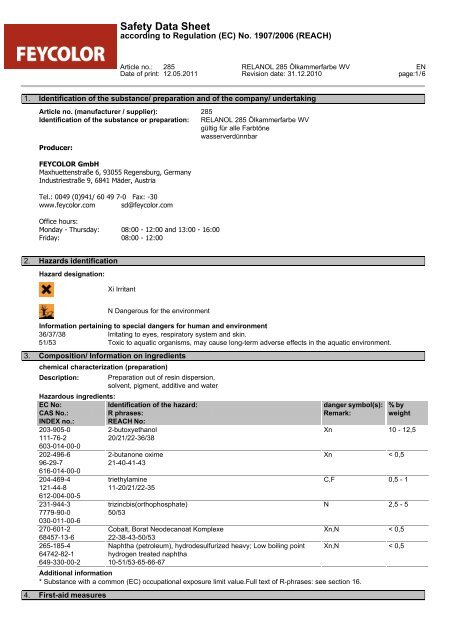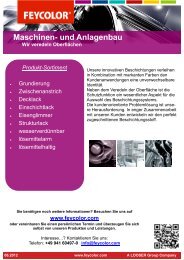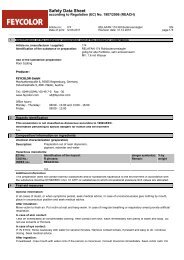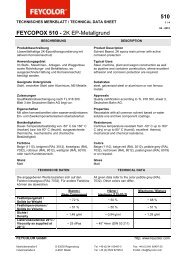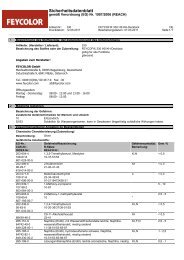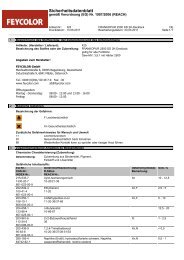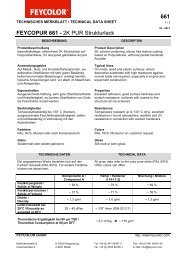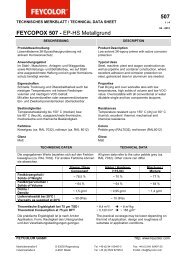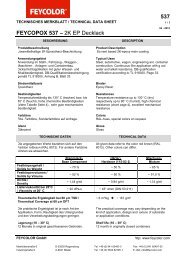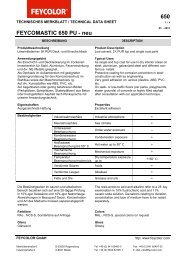Safety Data Sheet - Feycolor Gmbh
Safety Data Sheet - Feycolor Gmbh
Safety Data Sheet - Feycolor Gmbh
You also want an ePaper? Increase the reach of your titles
YUMPU automatically turns print PDFs into web optimized ePapers that Google loves.
<strong>Safety</strong> <strong>Data</strong> <strong>Sheet</strong><br />
according to Regulation (EC) No. 1907/2006 (REACH)<br />
Article no.: 285<br />
Date of print: 12.05.2011<br />
1. Identification of the substance/ preparation and of the company/ undertaking<br />
Article no. (manufacturer / supplier):<br />
Identification of the substance or preparation:<br />
Producer:<br />
FEYCOLOR GmbH<br />
Maxhuettenstraße 6, 93055 Regensburg, Germany<br />
Industriestraße 9, 6841 Mäder, Austria<br />
Tel.: 0049 (0)941/ 60 49 7-0 Fax: -30<br />
www.feycolor.com sd@feycolor.com<br />
Office hours:<br />
Monday - Thursday: 08:00 - 12:00 and 13:00 - 16:00<br />
Friday: 08:00 - 12:00<br />
2. Hazards identification<br />
Hazard designation:<br />
Xi Irritant<br />
N Dangerous for the environment<br />
RELANOL 285 Ölkammerfarbe WV EN<br />
Revision date: 31.12.2010 page:1 / 6<br />
285<br />
RELANOL 285 Ölkammerfarbe WV<br />
gültig für alle Farbtöne<br />
wasserverdünnbar<br />
Information pertaining to special dangers for human and environment<br />
36/37/38 Irritating to eyes, respiratory system and skin.<br />
51/53 Toxic to aquatic organisms, may cause long-term adverse effects in the aquatic environment.<br />
3. Composition/ Information on ingredients<br />
chemical characterization (preparation)<br />
Description: Preparation out of resin dispersion,<br />
solvent, pigment, additive and water<br />
Hazardous ingredients:<br />
EC No:<br />
CAS No.:<br />
INDEX no.:<br />
203-905-0<br />
111-76-2<br />
603-014-00-0<br />
202-496-6<br />
96-29-7<br />
616-014-00-0<br />
204-469-4<br />
121-44-8<br />
612-004-00-5<br />
231-944-3<br />
7779-90-0<br />
030-011-00-6<br />
270-601-2<br />
68457-13-6<br />
265-185-4<br />
64742-82-1<br />
649-330-00-2<br />
Identification of the hazard:<br />
R phrases:<br />
REACH No:<br />
2-butoxyethanol<br />
20/21/22-36/38<br />
2-butanone oxime<br />
21-40-41-43<br />
triethylamine<br />
11-20/21/22-35<br />
trizincbis(orthophosphate)<br />
50/53<br />
Cobalt, Borat Neodecanoat Komplexe<br />
22-38-43-50/53<br />
Naphtha (petroleum), hydrodesulfurized heavy; Low boiling point<br />
hydrogen treated naphtha<br />
10-51/53-65-66-67<br />
danger symbol(s):<br />
Remark:<br />
Additional information<br />
* Substance with a common (EC) occupational exposure limit value.Full text of R-phrases: see section 16.<br />
4. First-aid measures<br />
% by<br />
weight<br />
Xn 10 - 12,5<br />
Xn < 0,5<br />
C,F 0,5 - 1<br />
N 2,5 - 5<br />
Xn,N < 0,5<br />
Xn,N < 0,5
General information:<br />
<strong>Safety</strong> <strong>Data</strong> <strong>Sheet</strong><br />
according to Regulation (EC) No. 1907/2006 (REACH)<br />
Article no.: 285<br />
Date of print: 12.05.2011<br />
RELANOL 285 Ölkammerfarbe WV EN<br />
Revision date: 31.12.2010 page:2 / 6<br />
In all cases of doubt, or when symptoms persist, seek medical advice. In case of unconsciousness give nothing by mouth,<br />
place in unconscious position and seek medical advice.<br />
After inhalation::<br />
Move victim to fresh air. Put victim at rest and keep warm. In case of irregular breathing or respiratory arrest provide artificial<br />
respiration.<br />
In case of skin contact:<br />
Take off immediately all contaminated clothing. After contact with skin, wash immediately with plenty of water and soap. Do<br />
not use solvents or thinners.<br />
In case of eye contact:<br />
IF IN EYES: Rinse cautiously with water for several minutes. Remove contact lenses, if present and easy to do. Continue<br />
rinsing. Seek medical advice.<br />
After ingestion:<br />
If swallowed, rinse mouth with water (only if the person is conscious). Consult physician immediately. Keep victim calm. Do<br />
not induce vomiting.<br />
5. Fire-fighting measures<br />
Suitable extinguishing media:<br />
alcohol resistant foam, Carbon dioxide, Powder, spray mist, (water)<br />
Extinguishing media which must not be used for safety reasons:<br />
Strong water jet<br />
Special exposure hazards arising from the substance or preparation itself, its combustion products or from resulting<br />
gases:<br />
Dense black smoke occurs during fire. Inhaling hazardous decomposing products can cause serious health damage.<br />
Special protective equipment for firefighters:<br />
Provide a conveniently located respiratory protective device.<br />
Additional information:<br />
Cool closed containers that are near the source of the fire. Do not allow water used to extinguish fire to enter drains, ground or<br />
waterways. Treat runoff as hazardous.<br />
6. Accidental release measures<br />
Personal precautions<br />
Keep away from sources of ignition. Ventilate affected area. Do not breathe vapours. See protective measures under point 7<br />
and 8.<br />
Measures to protect the environment<br />
Do not allow to enter into surface water or drains. If the product contaminates lakes, rivers or sewages, inform competent<br />
authorities in accordance with local regulations.<br />
methods for cleaning up<br />
Isolate leaked material using non-flammable absorption agent (e.g. sand, earth, vermiculit, diatomaceous earth) and collect it<br />
for disposal in appropriate containers in accordance with the local regulations (see chapter 13). Clean using cleansing agents.<br />
Do not use solvents.<br />
7. Handling and storage<br />
Handling<br />
Advices on safe handling<br />
Avoid formation of flammable and explosive vapour concentrations in the air and exceeding the exposure limit values. Only<br />
use the material in places where open light, fire and other flammable sources can be kept away. Electrical equipment must be<br />
protected meeting the accepted standard. Product may become electrostatically charged. Provide earthing of containers,<br />
equipment, pumps and ventilation facilities. Anti-static clothing including shoes are recommended. Floors must be electrically<br />
conductive. Keep away from heat sources, sparks and open flames. Use only spark proof tools. Avoid contact with skin, eyes<br />
and clothes. Do not inhale dusts, particulates and spray mist when using this preparation. Avoid respiration of swarf. When<br />
using do not eat, drink or smoke. Personal protective equipment: refer to chapter 8. Do not empty containers with pressure -<br />
no pressure vessel! Always keep in containers that correspond to the material of the original container. Follow the legal<br />
protection and safety regulations.<br />
Precautions against fire and explosion:
<strong>Safety</strong> <strong>Data</strong> <strong>Sheet</strong><br />
according to Regulation (EC) No. 1907/2006 (REACH)<br />
Article no.: 285<br />
Date of print: 12.05.2011<br />
RELANOL 285 Ölkammerfarbe WV EN<br />
Revision date: 31.12.2010 page:3 / 6<br />
Vapours are heavier than air and will spread at floor level. Vapours form explosive mixtures with air.<br />
Storage<br />
Requirements for storerooms and containers:<br />
Storage in accordance with the Ordinance on Industrial <strong>Safety</strong> and Health (BetrSiVO). Keep container tightly closed. Do not<br />
empty containers with pressure - no pressure vessel! Smoking is forbidden. Access only for authorised persons. Store<br />
carefully closed containers upright to prevent any leaks.<br />
hints on joint storage<br />
Keep away from strongly acidic and alkaline materials as well as oxidizers.<br />
Further information on storage conditions<br />
Take care of instructions on label. Store in a well-ventilated and dry room at temperatures between 15 °C and 30 °C. Protect<br />
from heat and direct sunlight. Keep container tightly closed. Remove all sources of ignition. Smoking is forbidden. Access only<br />
for authorised persons. Store carefully closed containers upright to prevent any leaks.<br />
8. Exposure controls / Personal protection<br />
Technical measures to prevent exposure<br />
Provide good ventilation. This can be achieved with local or room suction. If this should not be sufficient to keep aerosol and<br />
solvent vapour concentration below the exposure limit values, a suitable respiratory protection must be used.<br />
Components with occupational exposure limits rsp. biological occupational exposure limits requiring monitoring:<br />
EC No:<br />
CAS No.:<br />
203-905-0<br />
111-76-2<br />
270-601-2<br />
68457-13-6<br />
265-185-4<br />
64742-82-1<br />
Description: type: Limit value<br />
STEL (EC) TWA (EC)<br />
unit<br />
2-butoxyethanol 50 123 mg/m3<br />
25 ppm<br />
Cobalt, Borat Neodecanoat Komplexe 0,1 mg/m3<br />
Naphtha (petroleum), hydrodesulfurized heavy; Low boiling<br />
point hydrogen treated naphtha<br />
Additional information<br />
Stated values are taken from the then applicable German TRGS 900 or the German VCI table for exposure limit values.<br />
TWA (EC): Occupational exposure limit value<br />
STEL (EC): Short term occupational exposure limit value<br />
Occupational exposure controls:<br />
200 ppm<br />
Respiratory protection:<br />
If concentration of solvents is beyond the occupational exposure limit values, approved and suitable respiratory protection must<br />
be used. Use only respiratory protection equipment with CE-symbol including four digit test number.<br />
Hand protection:<br />
For prolonged or repeated handling the following glove material must be used: solventresistant Latex gloves / solventresistant<br />
Latex gloves<br />
Observe the instructions and details for use, storage, maintenance and replacement provided by the protective glove<br />
manufacturer. Penetration time of glove material depending on intensity and duration of exposure to skin. Recommended glove<br />
articles: DIN EN 374 Barrier creams can help protecting exposed skin areas. In no case should they be used after contact.<br />
eye protection:<br />
Wear closely fitting protective glasses in case of splashes.<br />
Body protection:<br />
Wear antistatic clothing of natural fibers (cotton) or heat resistant synthetic fibers.<br />
Protective measures:<br />
After contact clean skin thoroughly with water and soap oder use appropriate cleanser.<br />
9. Physical and chemical properties<br />
Appearance:<br />
Physical state: liquid, see viscosity!<br />
Paint: see productname<br />
Odour: typical<br />
<strong>Safety</strong> relevant basis data Measured values unit Method Remark:<br />
Flash point: 62 °C<br />
Ignition temperature (AIT): 215 °C<br />
lower explosion limit: 1,9 Vol-%
<strong>Safety</strong> <strong>Data</strong> <strong>Sheet</strong><br />
according to Regulation (EC) No. 1907/2006 (REACH)<br />
Article no.: 285<br />
Date of print: 12.05.2011<br />
Upper explosion limit: 15,3 Vol-%<br />
Vapour pressure at 20 °C: n.a.<br />
density at 20 °C: 1,40 g/cm³<br />
Water solubility (g/l): partly soluble<br />
pH at 20 °C: n.a.<br />
Viscosity at 20 °C: 65 s 4 mm DIN 53211<br />
Solvent separation test (%): < 3 %<br />
Solid content (%): 57 % by weight<br />
solvent content:<br />
Organic solvents:: 11 % by weight<br />
Water: 31 % by weight<br />
10. Stability and reactivity<br />
RELANOL 285 Ölkammerfarbe WV EN<br />
Revision date: 31.12.2010 page:4 / 6<br />
Conditions to avoid<br />
Stable when applying the recommended regulations for storage and handling. Further information on correct storage: refer to<br />
chapter 7. Hazardous decomposition byproducts may form with exposure to high temperatures.<br />
Materials to avoid<br />
Keep away from strong acids, strong bases and strong oxidizing agents to avoid exothermic reactions.<br />
Hazardous decomposition products<br />
Hazardous decomposition byproducts may form with exposure to high temperatures, e.g.: carbon dioxide, carbon monoxide,<br />
smoke, nitrogen oxides.<br />
11. Toxicological information<br />
No data on preparation itself available.<br />
Practical experience<br />
Other observations:<br />
Inhaling of solvent components above the MWC-value can lead to health damage, e.g. irritation of the mucous membrane and<br />
respiratory organs, as well as damage to the liver, kidneys and the central nerve system. Indications for this are: headache,<br />
dizziness, fatigue, amyosthenia, dizziness, in serious cases: unconsciousness. Solvents may cause some of the<br />
aforementioned effects through skin resorption. Repeated or prolonged contact with the preparation may cause removal of<br />
natural fat from the skin resulting in non-allergic contact dermatitis and/or absorption through skin. Splashing may cause eye<br />
irritation and reversible damage.<br />
Overall Assessment on CMR properties:<br />
The components in this formulation do not meet the criteria for classification as CMR category 1 or 2.<br />
There is no information available on the preparation itself . The preparation has been assessed following the conventional<br />
method of the Dangerous Preparations Directive 1999/45/EC and classified according to the toxicological dangers.See<br />
chapters 2 and 15 for details.<br />
12. Ecological information<br />
Overall evaluation:<br />
There is no information available on the preparation itself .<br />
Do not allow to enter into surface water or drains.<br />
Results of PBT assessment<br />
The components in this formulation do not meet the criteria for classification as PBT or vPvB.<br />
13. Disposal considerations<br />
Appropriate disposal / Product<br />
Recommendation:<br />
Do not allow to enter into surface water or drains. This material and its container must be disposed of in a safe way. Waste<br />
disposal according to EC directives 75/442/EEC and 91/689/EEC in the corresponding versions, covering waste and<br />
dangerous waste.<br />
Control report for waste code/ waste marking according to EAKV:<br />
080111 waste paint and varnish containing organic solvents or<br />
other dangerous substances<br />
Contaminated packaging:
<strong>Safety</strong> <strong>Data</strong> <strong>Sheet</strong><br />
according to Regulation (EC) No. 1907/2006 (REACH)<br />
Article no.: 285<br />
Date of print: 12.05.2011<br />
Recommendation:<br />
Cleaned containers may be recycled. Vessels not properly emptied are special waste.<br />
14. Transport information<br />
Transport according to ADR/RID, IMDG and ICAO/IATA.<br />
Land transport (ADR/RID)<br />
Class: 9<br />
Hazard label: 9<br />
UN-No.: 3082<br />
Hazard identification number (Kemler No.) 90<br />
Proper Shipping Name Environmentally hazardous substance,<br />
liquid, n.o.s.<br />
contains: Trizinkbis (orthophosphat)<br />
Packing Group: III<br />
Tunnel restriction code: E<br />
RELANOL 285 Ölkammerfarbe WV EN<br />
Revision date: 31.12.2010 page:5 / 6<br />
Sea transport (IMDG)<br />
Class: 9<br />
Hazard label: 9<br />
EmS-No.: F-A, S-F<br />
UN-No.: 3082<br />
Proper Shipping Name ENVIRONMENTALLY HAZARDOUS SUBSTANCE,<br />
LIQUID, N.O.S.<br />
contains: Trizinkbis (orthophosphat)<br />
Packing Group: III<br />
Marine pollutant: p Trizinkbis (orthophosphat)<br />
Air transport (ICAO-TI / IATA-DGR)<br />
Class: 9<br />
Hazard label: 9<br />
UN-No.: 3082<br />
Proper Shipping Name Environmentally hazardous substance,<br />
liquid, n.o.s.<br />
contains: Trizinkbis (orthophosphat)<br />
Packing Group: III<br />
15. Regulatory information<br />
EU legislation<br />
Chemical <strong>Safety</strong> Assessment<br />
Chemical safety assessments for substances in this preparation were not carried out.<br />
Labelling (67/548/EEC or 1999/45/EC)<br />
Danger symbol(s) and danger term(s) for dangerous materials and preparations:<br />
Contains:<br />
Xi Irritant<br />
N Dangerous for the environment<br />
triethylamine<br />
R phrases:<br />
36/37/38 Irritating to eyes, respiratory system and skin.<br />
51/53 Toxic to aquatic organisms, may cause long-term adverse effects in the aquatic environment.<br />
S-phrases:<br />
26 In case of contact with eyes, rinse immediately with plenty of water and seek medical advice.<br />
38 In case of insufficient ventilation, wear suitable respiratory equipment.<br />
61 Avoid release to the environment. Refer to special instructions / safety data sheet.<br />
23 Do not breathe vapour.<br />
Special provisions concerning the labelling of certain mixtures
<strong>Safety</strong> <strong>Data</strong> <strong>Sheet</strong><br />
according to Regulation (EC) No. 1907/2006 (REACH)<br />
Article no.: 285<br />
Date of print: 12.05.2011<br />
RELANOL 285 Ölkammerfarbe WV EN<br />
Revision date: 31.12.2010 page:6 / 6<br />
99 Contains 2-butanone oxime, Cobalt, Borat Neodecanoat Komplexe. May produce an allergic reaction.<br />
Other regulations (EU):<br />
VOC-Richtlinie: Information according to 1999/13/EC about limitation of emissions of volatile organic compounds<br />
(VOC-guideline).<br />
VOC-value (in g/l) ISO 11890-2: 175<br />


